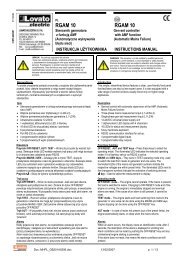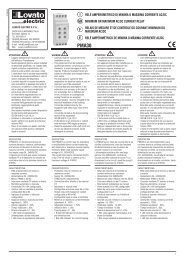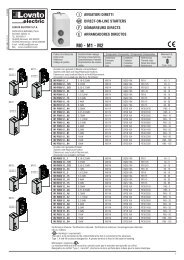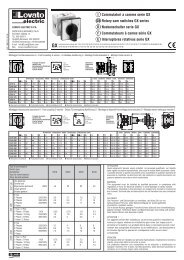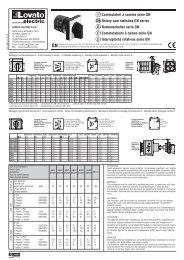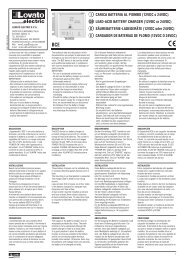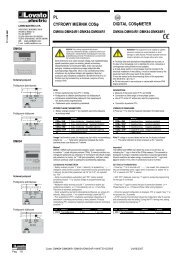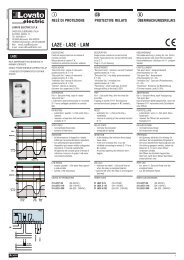Analizatory sieci typu DMG900 I 273 PL GB 0210
Analizatory sieci typu DMG900 I 273 PL GB 0210
Analizatory sieci typu DMG900 I 273 PL GB 0210
Create successful ePaper yourself
Turn your PDF publications into a flip-book with our unique Google optimized e-Paper software.
które mogą być przypisane do wyjść lub powiązane między nimi.<br />
Na przykład, możliwe jest stosowanie niektórych progów limitów<br />
do pomiarów wykonywanych przez miernik (napięcie, prąd, moc itp.).<br />
W tym przypadku wewnętrzna zmienna nazwana LIMx, będzie<br />
aktywowana, kiedy pomiary będą poza limitami zdefiniowanymi przez<br />
użytkownika, w odpowiednim menu.<br />
Ostatecznie możliwe jest zarządzanie 4 licznikami (CNT1…CNT4),<br />
które mogą zliczać impulsy pochodzące ze źródła zewnętrznego<br />
(przez wejście cyfrowe INPx) lub ilość razy kiedy określone warunki<br />
zostały potwierdzone. Na przykład definiując próg limitu LIMx jako żródło<br />
impulsów, będzie możliwe policzenie ile razy dany pomiar przekroczył<br />
ustalone limity.<br />
Ostatecznie możliwe jest zarządzanie 8 wejściami analogowymi,<br />
podłączonymi do zewnętrznych czujników analogowych (temperature,<br />
ciśnienie, przepływ itp.) Wartość odczytana z czujników może być<br />
skalowana do jakiejkolwiek jednostki pomiarów, wizualizowana na<br />
wyświetlaczu i przesyłana dalej. Wartość odczytana przez wejścia<br />
analogowe jest pokazywana na dedykowanej stronie. Mogą być<br />
używane do sterowania progami limitów LIMx.<br />
Poniższa tabela pokazuje wszystkie grupy WEJ/WYJ i wewnętrznych<br />
zmiennych dostępnych w <strong>DMG900</strong>.<br />
KOD OPIS ZAKRES<br />
INPx Wejścia cyfrowe 1…16<br />
OUTx Wyjścia cyfrowe 1…16<br />
LIMx Progi limitów 1…16<br />
BOOx Logika Boole’a 1…8<br />
REMx Zmienne kontrolowane zdalnie 1…8<br />
ALAx Alarmy 1…16<br />
PULx Impulsy zliczania energii 1…5<br />
CNTx Liczniki 1…4<br />
AINx Wejścia analogowe 1…8<br />
AOUx Wyjścia analogowe 1…8<br />
Status każdego I/O lub wewnętrznych zmiennych może być wyświetlony<br />
na ekranie na dedykowanej do tego stronie.<br />
Progi limitów (LIM)<br />
Progi limitów LIMn są wewnętrznymi zmiennymi, których status zależy<br />
od przekroczenia limitów pomiarów zdefiniowanych przez użytkownika<br />
(przykład: całkowita moc czynna większa niż 25kW).<br />
By ułatwić ustawianie progów, które mogą posiadać dużą rozpiętość,<br />
każdy z nich może być ustawiony na podstawie wartosci bazowej<br />
i mnożnika (na przykład: 25 x 1k = 25000).<br />
Dla każdego limitu LIM można przypisać dwa progi, najwyższy<br />
i najniższy.<br />
Znaczenie progów zależy od następujących funkcji:<br />
Funkcja Min: Ta funkcja definiuje najniższy próg jako punkt zadziałania,<br />
a najwyższy jako punkt kasowania. Zadziałanie dla progu LIM nastąpi kiedy<br />
wybrany pomiar jest niższy, niż ustawiony próg minimalny, dłużej<br />
niż zaprogramowane opóźnienie. Kiedy mierzona wartość staje się<br />
ponownie wyższa niż ustawiony próg maksymalny, dłużej niż czas<br />
opóźnienia, status LIM jest kasowany.<br />
Funkcja Max: Ta funkcja definuje najwyższy próg jako punkt zadziałania,<br />
a najniższy jako punkt kasowania. Zadziałanie dla progu LIM nastąpi, kiedy<br />
wybrany pomiar jest większy, niż ustawiony próg maksymalny, dłużej niż<br />
zaprogramowane opóźnienie. Kiedy mierzona wartość staje się ponownie<br />
niższa niż ustawiony próg minimalny, dłużej niż czas opóźnienia, status<br />
LIM jest kasowany.<br />
Funkcja Min+Max: Przy tej funkcji oba progi definiują punkty zadziałania.<br />
Kiedy mierzone wartości są mniejsze niż wartość minimalna i większe niż<br />
wartości maksymalne, to po uwzględnieniu opóźnienia, nastąpi zadziałanie<br />
LIM. Kiedy mierzone wartości powracają w granice limitów, to status LIM<br />
będzie natychmiast skasowany.<br />
Zadziałanie oznacza aktywacje lub de-aktywacje zmiennej LIM,<br />
w zależności od ustawień “Normalnego statusu”.<br />
Jeśli włączona jest blokada LIM, kasowanie można wykonać tylko<br />
ręcznie, przy użyciu dedykowanej komendy, w menu komend.<br />
Zobacz menu ustawień M08.<br />
be associated to the outputs or combined between them. For instance,<br />
it is possible to apply some limit thresholds to the measurements done<br />
by the multimeter (voltage, current, power, etc.). In this case, an internal<br />
variable named LIMx will be activated when the measurements will go<br />
outside the limits defined by the user through the dedicated setting<br />
menu.<br />
Furthermore, there are up to 4 counters (CNT1..CNT4) that can count<br />
pulses coming from an external source (through a digital input INPx) or<br />
the number of times that a certain condition as been verified. For<br />
instance, defining a limit threshold LIMx as the count source, it will be<br />
possible to count how many times one measurement has exceeded a<br />
certain limit.<br />
Finally it is possible to manage up to 8 analog inputs, connected to<br />
external analog sensors (temperature, pressure, flow etc). The value<br />
read from the sensors can be scaled to any unit of measure, visualized<br />
on the display and transmitted on the communication bus. The value<br />
read from analog inputs is shown on the dedicated display page. They<br />
can be used to drive LIMx limit thresholds.<br />
The following table groups all the I/O and the internal variables<br />
managed by the <strong>DMG900</strong>.<br />
CODE DESCRIPTION RANGE<br />
INPx Digital inputs 1…16<br />
OUTx Digital outputs 1…16<br />
LIMx Limit thresholds 1…16<br />
BOOx Boolean logic 1…8<br />
REMx Remote-controlled variables 1…8<br />
ALAx Alarms 1…16<br />
PULx Energy count pulses 1…5<br />
CNTx Counters 1…4<br />
AINx Analog inputs 1…8<br />
AOUx Analog outputs 1…8<br />
The status of each I/O or internal variable can be shown on the display in<br />
the dedicated page.<br />
Limit thresholds (LIM)<br />
The LIMn thresholds are internal variables whose status depends on<br />
the out-of-limits of one particular measurement set by the user (e.g.<br />
total active power higher than 25kW) among all those measured.<br />
To make the setting of the thresholds easier, since the limits can span<br />
in a very wide range, each of them can be set using a base number and<br />
a multiplier (for example: 25 x 1k = 25000).<br />
For each LIM, there are two thresholds (upper and lower). The upper<br />
threshold must always be set to a value higher than the lower threshold.<br />
The meaning of the thresholds depends on the following functions:<br />
Min function: the lower threshold defines the trip point, while the upper<br />
threshold is for the resetting. The LIM trips when the selected<br />
measurement is less than the Lower threshold for the programmed delay.<br />
When the measured value becomes higher than the upper setpoint, after<br />
the delay, the LIM status is reset.<br />
Max function: the upper threshold defines the trip point, while the lower<br />
threshold is for the resetting. The LIM trips when the selected<br />
measurement is more than upper threshold for the programmed delay.<br />
When the measured value decreases below the lower setpoint, after the<br />
delay, the LIM status is reset.<br />
Max+Min function: both thresholds are for tripping. When the measured<br />
value is less than lower or more than upper setpoints, then, after the<br />
respective delays, the LIM will trip. When the measured value returns<br />
within the limits, the LIM status will be immediately reset.<br />
Trip denotes either activation or de-activation of the LIM variable,<br />
depending on ‘Normal status’ setting.<br />
If the LIMn latch is enabled, the reset can be done only manually using<br />
the dedicated command in the commands menu.<br />
See setup menu M08.<br />
Doc: I<strong>273</strong><strong>PL</strong><strong>GB</strong> 0710_<strong>DMG900</strong> 09/07/2010 s. 12 / 30



